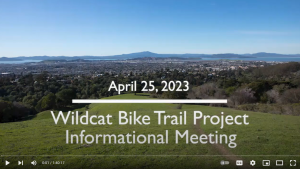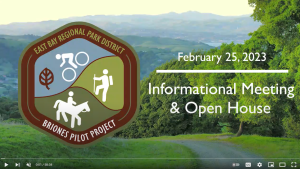
When the fire rekindled, Oakland Deputy Chief Matthews had assumed command as operations chief, Battalion Chief Riley, who later was killed, was assigned as division commander, and Battalion Chief Ronald Campos coordinated logistics from Oakland’s fire dispatch center.
District firefighters not trapped by the outbreak fought the fire along a line of defense four or five miles long between Sibley Volcanic Regional Preserve and Claremont Canyon, keeping the flames out of university lands, Tilden Regional Park, and Orinda.
Dennis Rein, who was a District police officer and also a District fire department lieutenant (and future District fire chief), set up a command post at the intersection of Fish Ranch Road and Grizzly Peak Boulevard.

Joining residents on a rooftop, Rein had watched on Saturday as firefighters fought the first blaze. Then he had returned to his police patrol.
On Sunday, Rein’s day off, he was paged at home and told to report for fire duty. As he drove towards Orinda on Bear Creek Road, he could see a column of smoke in the Oakland hills, “very large and starting to build.”
Rein drove west on deserted Highway 24, ascended Fish Ranch Road, and began to set up the staging area. At first he was the only person there. Then District firefighter Jack Kenny showed up driving a fire engine with a thousand gallon tank. Rein assigned him a crew including District firefighter Anne Rockwell, and sent them out on Grizzly Peak Boulevard.
Kenny was not a fire department officer. “I got a game day promotion,” he said. The Jack Attack, as his crew came to be known, fought to protect the KPFA radio towers and prevent the fire from jumping the road and burning towards Orinda.
Once they had established a perimeter, Kenny took a moment to look west to see where the main fire was located. “Everywhere I looked there was nothing but chimneys and smoking building foundations,” he said. “That hit me hard.”

San Francisco firefighters later told Kenny they had been at the ‘49ers football game at Candlestick Park when ash from the fire started floating down on the crowd.
Down in Claremont Canyon, District Fire Capt. Don Goodenow was with Park District firefighters trying to protect houses on Alvarado Road and Amito Avenue, a very dangerous area.
The District contingent included Bob Bouska, Brian Cordeiro, Dave Kalahele, Dimitri Montalvanos, Chris Garrett, Brit Thorsnes and others. Using wildland firefighting techniques, they were able to save many homes.
At one point, with flames all around, they had to evacuate the neighborhood. As Goodenow drove out, a downed power line ripped the light bar off his truck.
Fire Capt. Tim August made multiple trips with a water tender to supply the District firefighters on Alvarado Road, fighting the fire himself as well. When the tender’s electrical system burned out, August found a tow truck driver to tow the rig. On Claremont Avenue, with the tender pump dead, August had the tow truck driver raise the tender as high as possible, then used gravity to fill an Oakland fire engine. August, the Oakland firefighters and citizen volunteers extinguished the fire before it crossed Claremont Avenue towards Berkeley. Just as they did, the wind stopped. August saw the citizen volunteers drop to their knees and break down in tears. “I don’t know if it was tears of joy or sadness,” August said, “I think it was definitely both.”
Firefighters were well supplied with food. “There were these wonderful nuns on Fish Ranch Road handing out food,” Goodenow remembers. And residents of the Lomas Cantadas neighborhood, which had not been affected by the fire, set up a kitchen at the Tilden steam trains, cooking and serving to firefighters whatever they could scrounge from their pantries, like spaghetti with a chili topping. “The best food you ever ate,” he recalls.

Back up on Grizzly Peak Boulevard, Fire Lt. Anne Scheer was in charge of an all-female team of other park district staff. Early on they had tried to drive to the Fish Ranch Road command post, but had to retreat, because there was fire all around, including on the asphalt road. ”It was so dark I couldn’t decide if it was night or day,” she said. “It was a weird, eerie dark, lit up from the bottom.” They discovered the flames had melted the tires on their fire truck. Later, someone changed the tires for them.
Setting up at Grizzly Peak Estates, they had an assignment similar to the Jack Attack, putting out spot fires and preventing eastward spread.
Later they were ordered to put in a fire line from Grizzly Peak Boulevard to Claremont Avenue. They were assigned a civilian contractor, a bulldozer operator named Bill Everett. Scheer said the slope was so steep that the dozer began sliding down it sideways, but Everett was so skilled that the cut was successful anyway.
After that, they worked with a prisoner crew from the state. The prisoners didn’t seem used to working with female firefighters. “But they were great,” Scheer said. “They worked like dogs.”
At one point, Scheer and Wilson decided to go for coffee. “Everyone wanted coffee,” she said. All they had was this crap coffee.” So they drove to a restaurant on College Avenue in Berkeley, finding out, along the way, how devastating the fire had been.
When they walked into the restaurant, their Nomex uniforms dirty from firefighting, “everybody just started applauding.” They got all the coffee they wanted, free of charge.
Scheer hadn’t seen her young children for several days. Someone brought cell phones to the fire line and said the firefighters could phone home. Scheer’s son answered. He said, “Hi, Mommy! You’re not dead! Good! Want to talk to Al (his sister)?” Scheer still teases him about that.
Other district staff members were posted elsewhere around the perimeter of the burn area. Mark Ragatz and Jerry Kent held the line at the south end of Grizzly Peak Estates. Bea Soria was on Broadway Terrace with a unit from Lawrence Livermore Laboratories. Temescal Park Supervisor Frances Heath single-handedly saved the historic beach house at Lake Temescal.

Fear was certainly a factor, but more in retrospect. Anne Scheer’s assessment was a common one: “It was more traumatic after than during, I think. During, you’re just busy.”
Park District police had a substantial role, too. From near his home in Benicia, Officer Jon King (now a lieutenant) could see a huge column of smoke rising from across Carquinez Straits. Called in to duty along with all other police officers, King worked virtually without sleep for several days at traffic checkpoints keeping unauthorized people out of the fire area.
“We heard about our firefighters making real brave stands, saving homes,” he said.
One of his jobs was to obtain enough food to feed lots of firefighters. King and Officer Robert Worthington drove twice to the Orinda Safeway supermarket and spent $9,000 to $10,000 on fruit, sandwiches, water, granola bars and other easily handled items.
After the fire, King was assigned as liaison officer at a search and rescue command post at Lake Temescal. They had the difficult task of dealing with people who had lost everything in the fire. “It was so sad…”
Chief Rubini was out of town when the fire rekindled on Sunday morning. Traffic jams and detours delayed his return until about 2 p.m., when he arrived at the Fish Ranch Road command post. In early evening, incident command responsibilities were transferred to him from Lt. Rein.
Park District Police Chief Peter Sarna also responded to Fish Ranch Road, and by agreement with Oakland, assumed overall command of police and fire operations on that flank of the fire. Ultimately the Fish Ranch Road location became nerve center for a multitude of firefighting support services.

The Park District helicopter unit also served a vital role both days of the fire. At CDF’s request, the helicopter unit eventually assumed responsibility for managing air operations under extremely difficult flying conditions. Crews made many overflights of the fire to assess the situation and provide information for command decisions.
“District firefighters performed professionally and heroically throughout the firestorm, in some cases saving both property and lives,” Chief Sarna said in an initial report. “Police officers responded to assist Oakland police units in evacuation, traffic control and site security duties.”
For everyone involved, the firestorm was a memorable experience. And they said that all the tedious training really paid off. “For us as a department, I think that was our finest hour,” Rosario said. “We shined.”
“The thing about our department back then was that no matter where you were or what your assignment was, you were with a friend.” Nichols said.
“The neatest thing for me was the realization that the Park District really did get it right,” Rein declared. “It was a wild couple of days. I’m glad we survived it.”
Prior to the Oakland Hills firestorm, the catch phrase in the District fire department had always been, “I’ll see you at the big one.” Afterwards it was, “See you at the second biggest.” “We knew that was the biggest fire we’d ever see,” Wilson said.
Continued... >> The aftermath



